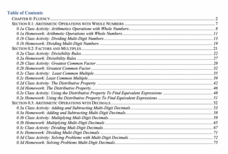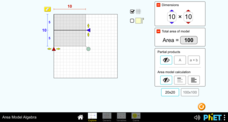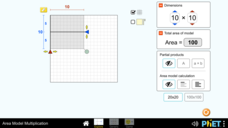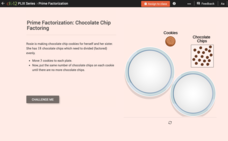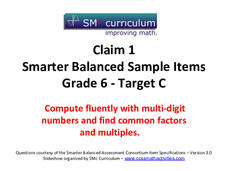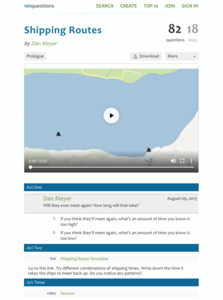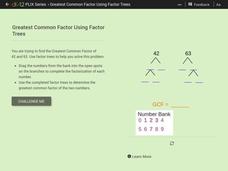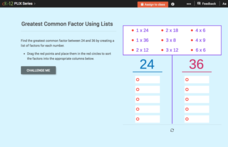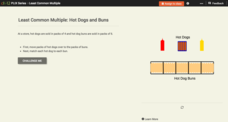University of California
Student Workbook: Algebra I
Need a helping hand in Algebra I? How about a giant, super-sized worksheet packet? Here is a resource that has worksheets for virtually every concept with some accompanying examples.
Scholastic
Study Jams! Least Common Multiple
RJ instructs your sixth graders in two different methods of determining least common multiples. The first is by listing several multiples of each number, and the second is by drawing factor trees. This is an ideal flipped classroom...
Curated OER
“I Can” Common Core! 6th Grade Math
Help your sixth graders reach their Common Core math standards by providing them with a checklist of "I can" statements for each standard. As each concept is covered, kids can check it off, as long as they can do what it states.
K20 LEARN
Prime Time
How many prime numbers are there between 1 and 100? By using a prime time resource, your scholars should be able to answer this question. Using arrays, they determine if numbers are prime or composite, and then write a prime...
Utah Education Network (UEN)
Expressions and Equations
Variables may be unknown, but expressions and equations are easy to understand. Pupils learn to write, evaluate, and simplify numeric and algebraic expressions. They also investigate how to write and solve simple equations and...
Utah Education Network (UEN)
Fluency
Become fluent in the language of mathematics. Scholars learn to divide multi-digit whole numbers as well as see how to determine the greatest common factor and least common multiple. They also investigate how to apply the distributive...
Gfletchy
Geared Up
Get the class's gears turning! Pupils first watch a video that introduces the situation: Given three gears, how many turns will it take for the dots shown on the gears to line up? They count the number of spurs on each gear, then use the...
CK-12 Foundation
CK-12 Middle School Math Concepts - Grade 6
Twelve chapters cover a multitude of math concepts found in the Common Core standards for sixth grade. Each title provides a brief explanation of what you will find inside the chapter—concepts from which you can click on and learn more...
PHET
Area Model Algebra
Expand the pupils knowledge of using area models to algebra. The interactive allows learners to use the same procedure of getting partial products when multiplying multi-digit numbers to multiplying polynomials. Scholars see how the...
PHET
Area Model Multiplication
Develop a solid understanding of multiplication. The interactive provides opportunities for learners to continue building a deep understanding of multiplication. Pupils use the application to find the product of two numbers and find...
CK-12 Foundation
Fraction Comparison with Lowest Common Denominators: Oranges and Blood Oranges
Comparing fractions is the focus of a five-question interactive in which mathematicians use oranges to answer real-world multiple-choice, true or false, and discussion questions.
CK-12 Foundation
Prime Factorization: Chocolate Chip Factoring
An interactive resource challenges mathematicians to show what they know about prime factorization. Five multiple-choice, true or false, and discussion questions use chocolate chip cookies to set a real-world application of the...
CCSS Math Activities
Smarter Balanced Sample Items: 6th Grade Math – Target C
Are you looking for review questions before standardized testing? Grade 6 Claim 1 Item Slide Show offers nine questions covering a variety of topics using decimals, factors, and multiples. With separate slides for answers, using the...
Mathed Up!
HCF, LCM, and Product of Primes
Give the class a prime example of using prime numbers. After reviewing prime factorization of numbers with the video, pupils use their knowledge to determine greatest common factors and least common multiples in the worksheet. The...
101 Questions
Shipping Routes
The product of the hard work is learning. Scholars use a simulation tool to collect information to analyze. They must decide when two ships traveling back and forth across a river at different rates will meet on the same side. The intent...
CK-12 Foundation
Greatest Common Factor Using Lists: Tiling the Kitchen Floor
Use a combination of tiling a rectangle to find area and find the greatest common factor of the lengths of two sides and the area they create. Pupils increase and decrease the sides of the rectangle before answer five questions...
CK-12 Foundation
Greatest Common Factor Using Factor Trees
Beginning with a description that sets the stage, learners are asked to break down the numbers 42 and 63 to find the greatest common denominator using factor trees. As they work through the factoring process, young mathematicians are...
CK-12 Foundation
Fraction Ordering with Lowest Common Denominators: Test Your Strength
Young mathematicians use a bell and hammer to see how high or low the puck goes. Then, they order the fractional values to demonstrate the greatest to lowest hit. Students then respond to several questions that require them to use...
CK-12 Foundation
Greatest Common Factor Using Lists
By creating a list of factors for two numbers, it is easier to see the greatest common factor. Each question in an interactive resource asks pupils to identify the greatest common factor for the numbers 24 and 36 in several...
CK-12 Foundation
Factor Pairs: Flower Garden
Arrange the dimensions of Marissa's rectangular flower garden so that 12 flowers can be grown. How many factor pairs does the number 12 have? What dimensions are necessary for a square shaped planter?
CK-12 Foundation
Least Common Multiple: Hot Dogs and Buns
Find the least common multiple of hotdog packages and bun packages in an interactive that allows pupils to drag and drop a set of four hot dogs into a pack of six buns to find the least common multiple of the sets.
CK-12 Foundation
Common Multiples: Sports Calendar
Using a calendar, basketballs, and tennis balls, young mathematicians determine the common multiples of four and six. Individuals drag and drop the balls onto the correct dates each sport will be played, allowing them to see which days...
EngageNY
End-of-Module Assessment Task: Grade 6 Math Module 2
Give learners a chance to shine. The last installment of a 21-part series is an end-of-module assessment. Scholars show their understanding of operations with decimals and division of fractions by solving problems in the context of a...
EngageNY
The Euclidean Algorithm as an Application of the Long Division Algorithm
Individuals learn to apply the Euclidean algorithm to find the greatest common factor of two numbers. Additionally, the lesson connects greatest common factor to the largest square that can be drawn in a rectangle.







